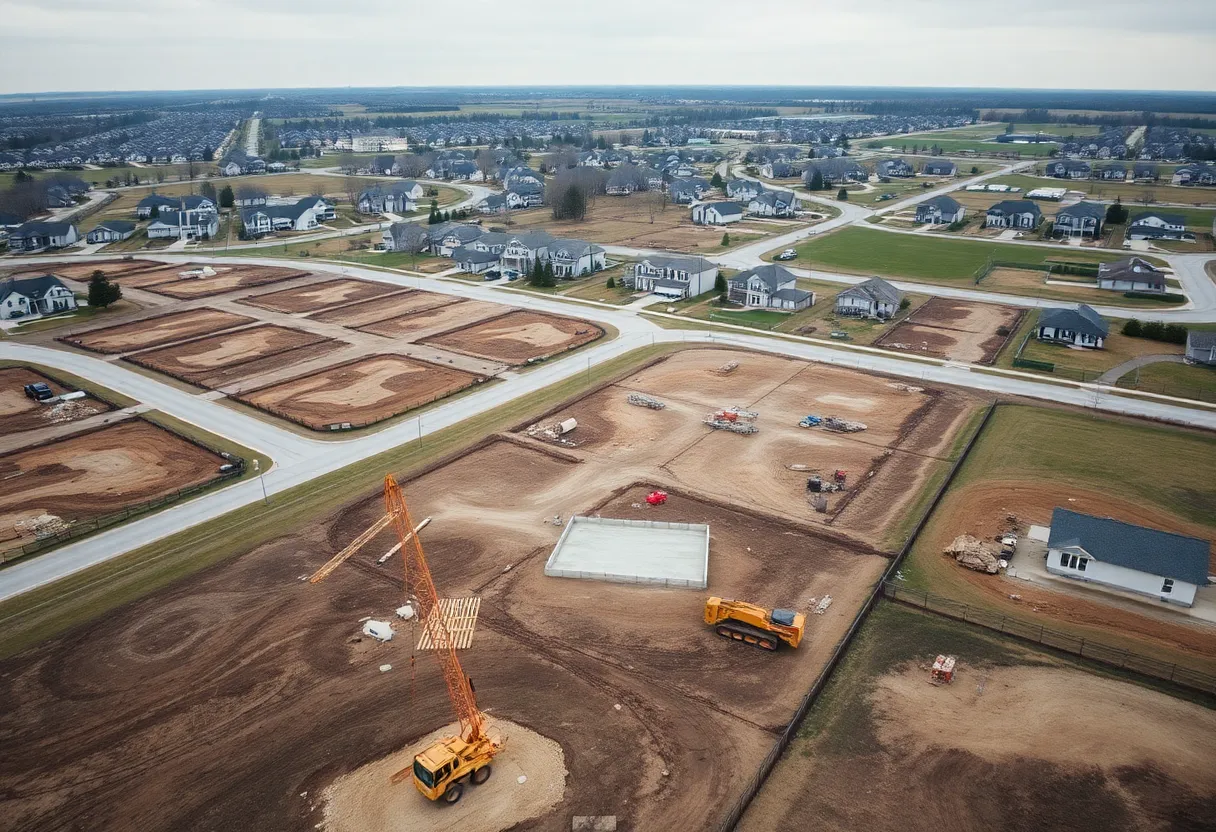, October 8, 2025
News Summary
The White House called on major government-controlled mortgage backers to encourage large homebuilders to accelerate construction, sparking questions about how that would work amid a softening housing market. Fannie Mae and Freddie Mac together guarantee a large share of U.S. mortgages, and any shift in their practices could affect construction finance. Experts say undeveloped lots often sit idle due to weak demand, higher building costs, labor shortages, zoning and permitting delays, and condo financing hurdles. Industry groups and regulators signaled attention, but no concrete programs were announced and analysts stress coordinated action is needed to boost supply.
President Calls on Mortgage Giants to Push Builders to Build; Industry Says Fixes Are Not That Simple
Key point: A public appeal from the president directed two government-controlled mortgage firms to encourage large homebuilders to resume building, citing a claim that builders are holding millions of undeveloped lots. The request met immediate confusion from regulators, builders and housing economists because it did not include a clear plan for how the mortgage firms would accomplish that goal.
Immediate development
The president posted a message on his social platform asking the two mortgage firms commonly known as Fannie Mae and Freddie Mac to take steps to get big homebuilders building again. The post included an assertion that builders are sitting on about 2 million empty lots. The regulator that oversees those firms shared the post and said he would look into it, but no detailed mechanism or program was outlined.
Why this matters
Fannie Mae and Freddie Mac together guarantee more than half of U.S. residential mortgages, so any shift in their policies could affect lending for home construction and sales. Yet how the firms could directly force or persuade builders to start projects is unclear. Industry and policy analysts point to a mix of weak buyer demand, higher construction costs, labor shortages, and local zoning or permitting barriers as the main reasons many lots remain unbuilt.
Market context and numbers
Housing supply has lagged demand for years. Independent analysis estimates a national housing supply gap in the millions, with one estimate placing the shortfall at roughly 3.8 million homes in 2024. At current construction rates, analysts say closing that gap could take multiple years. Recent housing indicators show mixed signals: median sale prices rose modestly year over year, overall inventory increased, home sales slipped, and new listings from builders declined as many builders chose to delay bringing newly built homes to market.
Specific construction metrics included a sharp monthly drop in housing starts in August, with the seasonally adjusted annual rate falling by a notable percentage to about 1.307 million. A measure of lots and units permitted or listed but not under construction reached multi-decade highs, with new single-family homes for sale but not yet started exceeding 100,000 units in the summer.
What builders report
Builder surveys show growing caution. Nearly four in ten builders reported price cuts recently, the highest share since early in the pandemic, and sales incentives are widely used. Builder sentiment remained low by historical standards, and many firms say buyer traffic has weakened because homes are less affordable. Builders point to material tariffs, rising costs, and labor shortages as direct pressures that make starting new projects riskier.
What economists say about the empty-lot claim
Housing economists caution that the presence of many undeveloped lots does not, by itself, mean builders are intentionally limiting supply. Analysts say a large share of those lots sit idle because financing for vertical construction is costly or hard to secure, presale requirements for certain developments are tough to meet, and local zoning or permitting delays prevent projects from starting quickly. One expert noted that new construction reduces prices and rents in the long run where it is allowed to proceed, but the barriers vary greatly across regions.
Possible roles for the mortgage firms
Observers outlined several ways the mortgage firms could help without direct control over builders: speed loan processing for construction loans, develop or expand loan products for condo developments, relax or expedite approval rules that slow condominium financing, and work with lenders to lower costs of construction and development credit. Industry groups welcomed the idea of public-private cooperation but emphasized that removing regulatory and local permitting barriers will be essential for large-scale improvement.
Policy and timing
Discussions about the future status of these mortgage firms have continued since the 2008 financial crisis, including talks about privatization and reform. Any major new programs to boost construction would require careful design and time to implement. Broader economic signals may help: modest declines in long-term mortgage rates were observed recently as markets priced in potential central bank rate cuts later in the year, which could ease financing costs for developers over time. A concurrent government shutdown at the time also briefly constrained access to updated labor data, adding to near-term uncertainty.
Bottom line
The president’s public request to the mortgage firms intensified attention on housing supply, but industry insiders and economists say the problems are complex and local. Short-term actions by mortgage guarantors could smooth lending for some projects, yet resolving the national supply gap will require a combination of financing solutions, eased permitting and zoning, more construction labor, and lower material costs. Market indicators show builders are reacting cautiously for now.
FAQ
Q: What was asked of the mortgage firms?
A public request was made for Fannie Mae and Freddie Mac to encourage large homebuilders to increase homebuilding activity, referencing a claim that many lots remain empty.
Q: Can those firms force builders to build?
No. The firms can influence financing and loan approval processes but cannot compel private builders to start projects. Builders cite demand, costs and permitting as primary constraints.
Q: Are there really 2 million empty lots?
The figure was cited publicly but experts say many lots are not under construction for reasons including weak buyer demand, financing limits, higher costs and local permitting rules. The exact count and interpretation vary by data source and region.
Q: What could the mortgage firms do quickly?
Possible near-term steps include streamlining loan approvals for construction or condo projects and expanding loan products that target new-construction financing, though such changes take time to design and deploy.
Q: Will this immediately lower home prices?
Unlikely in the short term. New construction helps affordability over time, but most experts say local policy changes and a ramp-up in building capacity are needed before prices ease materially in constrained markets.
{
“@context”: “https://schema.org”,
“@type”: “FAQPage”,
“mainEntity”: [
{
“@type”: “Question”,
“name”: “What was asked of the mortgage firms?”,
“acceptedAnswer”: {
“@type”: “Answer”,
“text”: “A public request was made for Fannie Mae and Freddie Mac to encourage large homebuilders to increase homebuilding activity, referencing a claim that many lots remain empty.”
}
},
{
“@type”: “Question”,
“name”: “Can those firms force builders to build?”,
“acceptedAnswer”: {
“@type”: “Answer”,
“text”: “No. The firms can influence financing and loan approval processes but cannot compel private builders to start projects. Builders cite demand, costs and permitting as primary constraints.”
}
},
{
“@type”: “Question”,
“name”: “Are there really 2 million empty lots?”,
“acceptedAnswer”: {
“@type”: “Answer”,
“text”: “The figure was cited publicly but experts say many lots are not under construction for reasons including weak buyer demand, financing limits, higher costs and local permitting rules. The exact count and interpretation vary by data source and region.”
}
},
{
“@type”: “Question”,
“name”: “What could the mortgage firms do quickly?”,
“acceptedAnswer”: {
“@type”: “Answer”,
“text”: “Possible near-term steps include streamlining loan approvals for construction or condo projects and expanding loan products that target new-construction financing, though such changes take time to design and deploy.”
}
},
{
“@type”: “Question”,
“name”: “Will this immediately lower home prices?”,
“acceptedAnswer”: {
“@type”: “Answer”,
“text”: “Unlikely in the short term. New construction helps affordability over time, but most experts say local policy changes and a ramp-up in building capacity are needed before prices ease materially in constrained markets.”
}
}
]
}
Key facts at a glance
| Item | Detail / Figure |
|---|---|
| Public request | Mortgage firms asked to prompt big builders to build |
| Claim about empty lots | Approximately 2 million lots cited |
| Mortgage market reach | Fannie Mae and Freddie Mac together back over half of residential mortgages |
| Estimated housing gap | Roughly 3.8 million homes short as of 2024 estimate |
| Recent housing starts | Seasonally adjusted annual rate near 1.307 million after a notable monthly drop |
| Builder behavior | About 39% reported cutting prices; 65% using sales incentives |
| Mortgage rate snapshot | Average 30-year fixed rate around the mid 6 percent range |
| Primary barriers to building | Weak buyer demand, higher costs, labor shortages, tariffs, and local zoning/permitting rules |
This article summarizes publicly reported developments and industry data to explain the context and potential implications for housing supply and construction finance.
Deeper Dive: News & Info About This Topic
Additional Resources
- Reuters: Trump calls on Fannie Mae, Freddie Mac to get big homebuilders going
- Wikipedia: Fannie Mae
- Bloomberg: Trump call for Fannie, Freddie to spur building is a mystery
- Google Search: Trump Fannie Freddie spur building
- U.S. News: Trump calls on Fannie Mae and Freddie Mac to get big homebuilders going
- Encyclopedia Britannica: Fannie Mae
- Investing.com: Trump yet to decide on Fannie Mae, Freddie Mac IPO — Pulte says
- Google Scholar: housing supply Fannie Freddie 2025
- Newsweek: Donald Trump housing update
- Google News: Trump Fannie Mae Freddie Mac homebuilders
Author: Construction CA News
The CALIFORNIA STAFF WRITER represents the experienced team at constructioncanews.com, your go-to source for actionable local news and information in California and beyond. Specializing in "news you can use," we cover essential topics like product reviews for personal and business needs, local business directories, politics, real estate trends, neighborhood insights, and state news affecting the area—with deep expertise drawn from years of dedicated reporting and strong community input, including local press releases and business updates. We deliver top reporting on high-value events such as the Rose Parade, Coachella, Comic-Con, and the California State Fair. Our coverage extends to key organizations like the California Building Industry Association and Associated General Contractors of California, plus leading businesses in technology and entertainment that power the local economy such as Apple and Alphabet. As part of the broader network, including constructionnynews.com, constructiontxnews.com, and constructionflnews.com, we provide comprehensive, credible insights into the dynamic landscape across multiple states.




